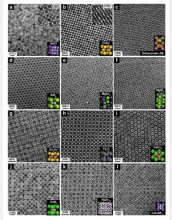News Release 06-005
A New Family of Self-Assembling Nanolattices

Some latticework structures created by the self-assembly of different nanoparticles.
January 5, 2006
This material is available primarily for archival purposes. Telephone numbers or other contact information may be out of date; please see current contact information at media contacts.
Inspired by the way most solids form in nature, with free-floating molecules spontaneously assembling themselves into a rigid, highly uniform array, researchers from Columbia University and IBM have learned how to create a whole new family of intricate structures out of artificial nanoscale crystals.
Because the nanocrystals can be chosen for their precise magnetic and electronic properties, says the group's spokesperson, Stephen O'Brien of Columbia, these new structures could have broad application for magnetic storage and nanoscale electronics.
"You can think of nanocrystals as building blocks like the toy Lego," says O'Brien, "in which a larger structure can be assembled by locking in the pieces according to their shape and the way they prefer to join to each other. Except all of this is on an incredibly small length scale -- billionths of a meter."
The group described 10 of the new structures in the Jan. 5, 2006, issue of the journal Nature. Their work was supported by the National Science Foundation (NSF) and the New York State Office of Science, Technology and Academic Research through NSF's Materials Research Science and Engineering Center at Columbia.
For more information, see the Columbia University news release.-NSF-
Media Contacts
M. Mitchell Waldrop, NSF, (703) 292-7752, email: mwaldrop@nsf.gov
Alex Lyda, Columbia University, (212) 854-5276, email: mal2133@columbia.edu
Principal Investigators
Stephen O'Brien, Columbia University, (212) 854-9478, email: so188@columbia.edu
Related Websites
Columbia University news release: http://www.columbia.edu/cu/news/06/01/superlattice.html
The U.S. National Science Foundation propels the nation forward by advancing fundamental research in all fields of science and engineering. NSF supports research and people by providing facilities, instruments and funding to support their ingenuity and sustain the U.S. as a global leader in research and innovation. With a fiscal year 2023 budget of $9.5 billion, NSF funds reach all 50 states through grants to nearly 2,000 colleges, universities and institutions. Each year, NSF receives more than 40,000 competitive proposals and makes about 11,000 new awards. Those awards include support for cooperative research with industry, Arctic and Antarctic research and operations, and U.S. participation in international scientific efforts.
Connect with us online
NSF website: nsf.gov
NSF News: nsf.gov/news
For News Media: nsf.gov/news/newsroom
Statistics: nsf.gov/statistics/
Awards database: nsf.gov/awardsearch/
Follow us on social
Twitter: twitter.com/NSF
Facebook: facebook.com/US.NSF
Instagram: instagram.com/nsfgov
